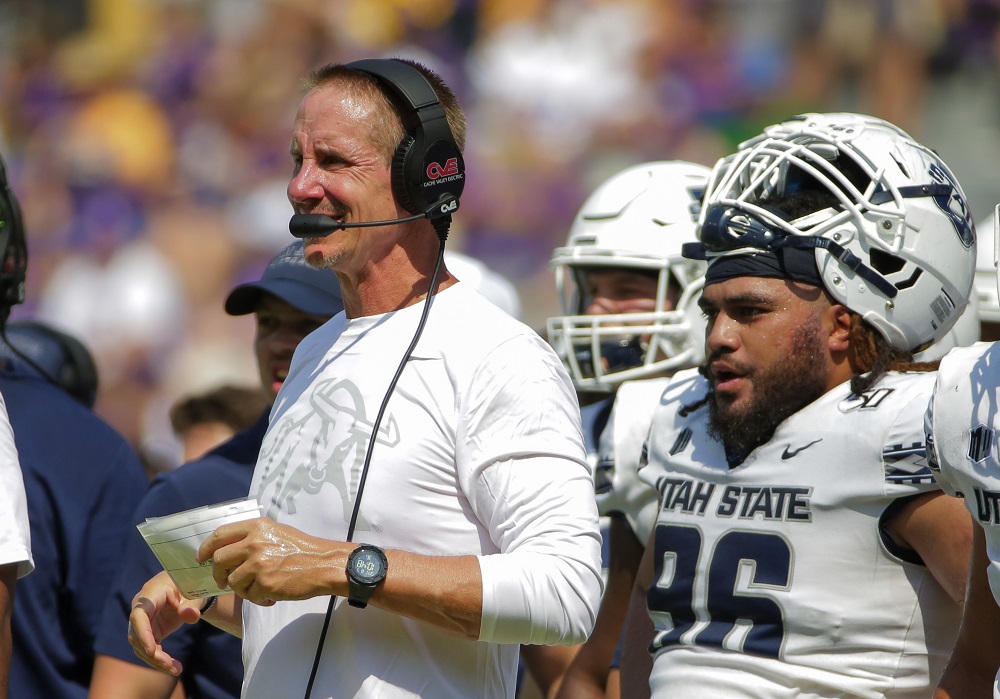Coaches come and go. Even great coaches come and go. But Andersen wasn’t just great. He was transcendent. Andersen’s scorching hot recovery and his screeching halt will indeed guarantee that his legacy will live on forever. Even outside of that, however, Andersen had many memorable moments and unforgettable eccentricities.
During his two incumbencies, he coached household names such as Chuckie Keeton, Bobby Wagner, Robert Turbin, Jordan Love, Savon Scarver, and Deven Thompkins, among others. Tying his name to theirs ensures his memorability.
But Andersen doesn’t need help etching his name into history. Not even from the likes of Wagner, Keeton, or Love.
There is something unforgettable about the complex legacy of Gary Andersen. Everywhere he has gone, he has been followed by inexplicable events and bewildering circumstances Andersen is an enigma, an outlier, a mystery, and, as some have noted, a puzzle.
“The man doesn’t move at the same pace or in the same way as others. He doesn’t think like others. He doesn’t react in expected form. He is a puzzle with a sweatshirt on his back and a whistle around his neck, a sweatshirt and whistle that are now left on the ground.” Gordon Monson wrote of Andersen.
Andersen’s two memorable runs with the Aggies led to a less memorable and very peculiar quirk of Andersen’s legacy. More specifically, the conclusion of each of his head coaching gigs at Utah State, led to an uncommon pattern.
One piece of evidence of his puzzle-like career and legacy is the way he set up the Utah State program for success. Usually, setting a program up for success is the mark of a good coach. The first time Andersen left, this was true. The first post-Andersen era was bliss. Andersen built a winning program with a strong culture. It was a destination for talented players and it was making more money than it ever had before. Success in the wake of Andersen’s contributions was inevitable.
The second time was different. Although the second post-Andersen era was again bliss, starting with one of the best and most decorated seasons in Utah State history, it wasn’t thanks to Andersen. At least not in the same way.
Andersen’s whiplashed departure paved the way for Blake Anderson’s triumphant arrival. Despite the phonetic confusion of replacing coach Andersen with coach Anderson, this has so far shown to be unequivocally the right move by the administration.
Anderson notably had zero ties to the state of Utah, and other than a three-year stop at New Mexico, he had no ties to the Mountain West. In some cases, that could have been concerning but with the unique situation Utah State was in, it could have actually bolstered his chances. The Aggies were in desperate need of a fresh start. The Aggies needed to completely cut ties with the man that gave them everything.
Anderson brought in a stellar coaching staff and an influx of talent from his previous school, Arkansas State, as well as other schools from around the country. He had a strong returning core already in Logan and even convinced some Utah State athletes to withdraw from the transfer portal.
The squad Anderson assembled, coach by himself, defensive coordinator Ephram Banda, formerly at the University of Miami, and offensive coordinator Anthony Tucker, previously at UCF, snapped the program back into shape in a matter of months.
There is something about the way the 2020 season ended in abject failure and embarrassment that enabled Utah state to somehow grow stronger. In a strange twist of fate, Andersen’s unintended scorched earth campaign set the Aggies up for their first ever Mountain West title run.
It’s impossible to prove the counterfactual, but it is not probable that Utah State would be the current champions of the Mountain West conference if Andersen stayed with the team for another year, or even until the end of the season.
Winning a championship in the Mountain West is very difficult and the margin of error is slim. If things hadn’t gone exactly the way they did, the results would not match what they are today. Some call it fate, some call it statistical probability, some call it ‘having to play Boise State every year,’ but whatever it’s called, it finally led to a Mountain West title for the Aggies and it’s unlikely that they could have done it any other way.
In a way, Andersen unintentionally sacrificed his own reputation for the good of the team.
Like a forest fire replenishing the soil with nutrients to create a fertile environment conducive to accelerated future growth, the 2020 football season was scary and dangerous, and nearly burned everything down, but necessary for new life.
Unlike a forest fire, however, on his way out, Andersen was offered 2.7 million dollars.
He declined. This is one of the most unique and well-known recurring oddities of his career. Andersen had an unconventional tendency to leave money behind. When he refused the money, he said it simply, it just “wasn’t his style.”
To state the obvious, 2.7 million dollars is a lot of money. There’s really no other way to put it. Yet, Andersen turned it down because it “wasn’t his style.” On its own, could seem to have been an unprecedented move. It wasn’t.
The Complex Legacy of Gary Andersen: The Enduring Influence of Coach Andersen
